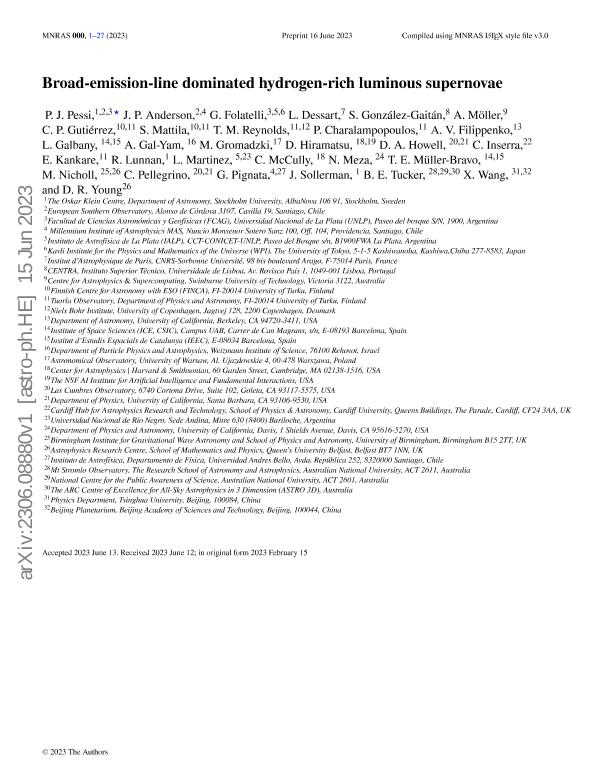Artículo
Broad-emission-line dominated hydrogen-rich luminous supernovae
Pessi, Priscila Jael ; Anderson, J. P.; Folatelli, Gaston
; Anderson, J. P.; Folatelli, Gaston ; Dessart, L.; González Gaitán, S.; Möller, A.; Gutiérrez, C. P.; Mattila, S.; Reynolds, T. M.; Charalampopoulos, P.; Filippenko, A.V.; Galbany, Lluís; Gal Yam, A.; Gromadzki, M.; Hiramatsu, D.; Howell, D. A.; Inserra, C.; Kankare, E.; Lunnan, R.; Martinez, Laureano
; Dessart, L.; González Gaitán, S.; Möller, A.; Gutiérrez, C. P.; Mattila, S.; Reynolds, T. M.; Charalampopoulos, P.; Filippenko, A.V.; Galbany, Lluís; Gal Yam, A.; Gromadzki, M.; Hiramatsu, D.; Howell, D. A.; Inserra, C.; Kankare, E.; Lunnan, R.; Martinez, Laureano ; McCully, C.; Meza, N.; Müller Bravo, T. E.; Nicholl, M.; Pellegrino, C.; Pignata, G.; Sollerman, J.; Tucker, B. E.; Wang, X.; Young, D. R.
; McCully, C.; Meza, N.; Müller Bravo, T. E.; Nicholl, M.; Pellegrino, C.; Pignata, G.; Sollerman, J.; Tucker, B. E.; Wang, X.; Young, D. R.
 ; Anderson, J. P.; Folatelli, Gaston
; Anderson, J. P.; Folatelli, Gaston ; Dessart, L.; González Gaitán, S.; Möller, A.; Gutiérrez, C. P.; Mattila, S.; Reynolds, T. M.; Charalampopoulos, P.; Filippenko, A.V.; Galbany, Lluís; Gal Yam, A.; Gromadzki, M.; Hiramatsu, D.; Howell, D. A.; Inserra, C.; Kankare, E.; Lunnan, R.; Martinez, Laureano
; Dessart, L.; González Gaitán, S.; Möller, A.; Gutiérrez, C. P.; Mattila, S.; Reynolds, T. M.; Charalampopoulos, P.; Filippenko, A.V.; Galbany, Lluís; Gal Yam, A.; Gromadzki, M.; Hiramatsu, D.; Howell, D. A.; Inserra, C.; Kankare, E.; Lunnan, R.; Martinez, Laureano ; McCully, C.; Meza, N.; Müller Bravo, T. E.; Nicholl, M.; Pellegrino, C.; Pignata, G.; Sollerman, J.; Tucker, B. E.; Wang, X.; Young, D. R.
; McCully, C.; Meza, N.; Müller Bravo, T. E.; Nicholl, M.; Pellegrino, C.; Pignata, G.; Sollerman, J.; Tucker, B. E.; Wang, X.; Young, D. R.
Fecha de publicación:
08/2023
Editorial:
Wiley Blackwell Publishing, Inc
Revista:
Monthly Notices of the Royal Astronomical Society
ISSN:
0035-8711
Idioma:
Inglés
Tipo de recurso:
Artículo publicado
Clasificación temática:
Resumen
Hydrogen-rich Type II supernovae (SNe II) are the most frequently observed class of core-collapse SNe (CCSNe). However, most studies that analyse large samples of SNe II lack events with absolute peak magnitudes brighter than −18.5 mag at rest-frame optical wavelengths. Thanks to modern surveys, the detected number of such luminous SNe II (LSNe II) is growing. There exist several mechanisms that could produce luminous SNe II. The most popular propose either the presence of a central engine (a magnetar gradually spinning down or a black hole accreting fallback material) or the interaction of supernova ejecta with circumstellar material (CSM) that turns kinetic energy into radiation energy. In this work, we study the light curves and spectral series of a small sample of six LSNe II that show peculiarities in their H α profile, to attempt to understand the underlying powering mechanism. We favour an interaction scenario with CSM that is not dense enough to be optically thick to electron scattering on large scales – thus, no narrow emission lines are observed. This conclusion is based on the observed light curve (higher luminosity, fast decline, blue colours) and spectral features (lack of persistent narrow lines, broad H α emission, lack of H α absorption, weak, or non-existent metal lines) together with comparison to other luminous events available in the literature. We add to the growing evidence that transients powered by ejecta–CSM interaction do not necessarily display persistent narrow emission lines.
Archivos asociados
Licencia
Identificadores
Colecciones
Articulos(IALP)
Articulos de INST.DE ASTROFISICA LA PLATA
Articulos de INST.DE ASTROFISICA LA PLATA
Citación
Pessi, Priscila Jael; Anderson, J. P.; Folatelli, Gaston; Dessart, L.; González Gaitán, S.; et al.; Broad-emission-line dominated hydrogen-rich luminous supernovae; Wiley Blackwell Publishing, Inc; Monthly Notices of the Royal Astronomical Society; 523; 4; 8-2023; 5315-5340
Compartir
Altmétricas



